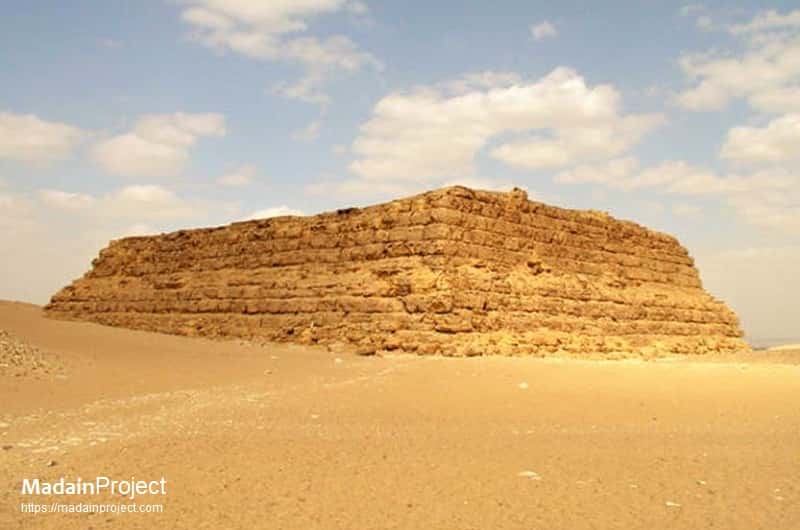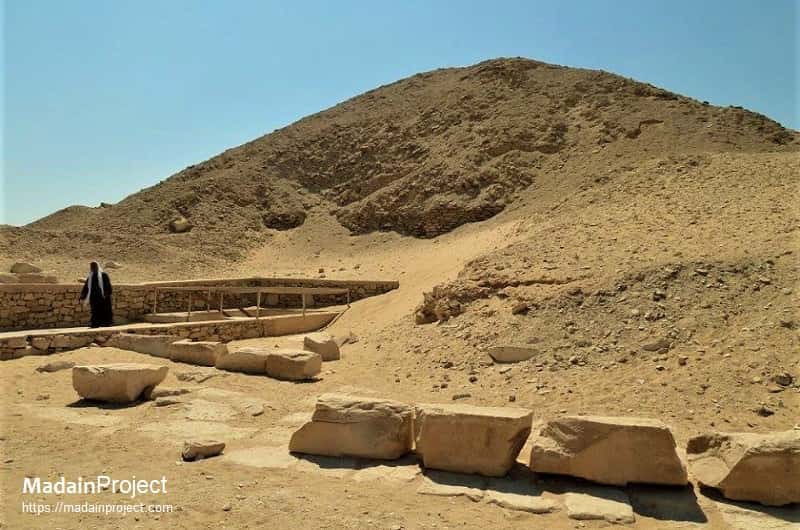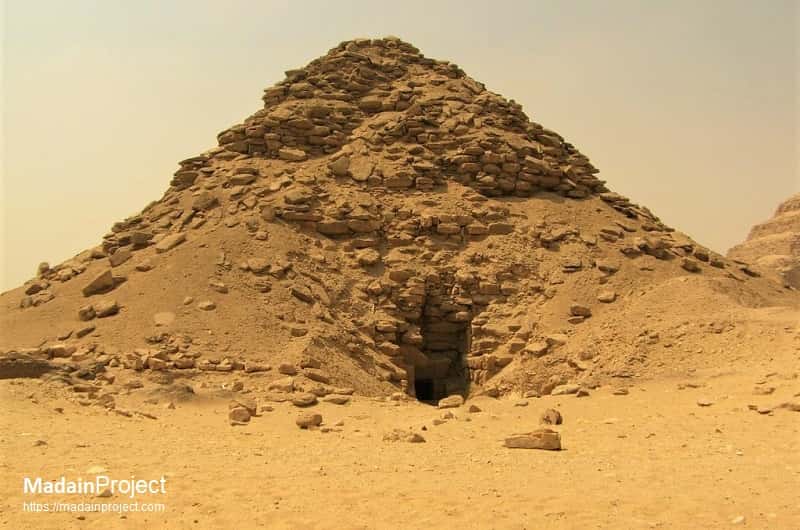Saqqara (سقارة), aslo spelled Sakkara or Saccara in English, is an ancient burial ground of Egyptian kings and royals, serving as the necropolis for the ancient Egyptian capital, Memphis.
The Saqqara necropolis contains numerous pyramids, including the world-famous Step pyramid of Djoser, sometimes referred to as the Step Tomb, and a number of mastaba tombs. Located some 30 km (19 mi) south of modern-day Cairo, Saqqara covers an area of around 7 by 1.5 kilometers (4.3 by 0.9 miles). Saqqara contains the oldest complete stone building complex known in history, the Pyramid of Djoser, built during the Third Dynasty.

This area, known as the Bubasteion or catacombs for the cats of the Cat-goddess Bastet, dates to the Late Period. Here, rock cut tombs were dug from the beginning of the 18th dynasty – including the Amarna Period – up to the time of Ramses II. The most renowned tombs in this cliff are for Aper-El, vizier of Amenophis III; Maya, wet-nurse of king Tutankhamun and the Hatiay scribe of the Aton temple in Memphis. Read more

This area, known as the Bubasteion or catacombs for the cats of the Cat-goddess Bastet, dates to the Late Period. Here, rock cut tombs were dug from the beginning of the 18th dynasty – including the Amarna Period – up to the time of Ramses II. The most renowned tombs in this cliff are for Aper-El, vizier of Amenophis III; Maya, wet-nurse of king Tutankhamun and the Hatiay scribe of the Aton temple in Memphis. Read more

This area, known as the Bubasteion or catacombs for the cats of the Cat-goddess Bastet, dates to the Late Period. Here, rock cut tombs were dug from the beginning of the 18th dynasty – including the Amarna Period – up to the time of Ramses II. The most renowned tombs in this cliff are for Aper-El, vizier of Amenophis III; Maya, wet-nurse of king Tutankhamun and the Hatiay scribe of the Aton temple in Memphis. Read more

This area, known as the Bubasteion or catacombs for the cats of the Cat-goddess Bastet, dates to the Late Period. Here, rock cut tombs were dug from the beginning of the 18th dynasty – including the Amarna Period – up to the time of Ramses II. The most renowned tombs in this cliff are for Aper-El, vizier of Amenophis III; Maya, wet-nurse of king Tutankhamun and the Hatiay scribe of the Aton temple in Memphis. Read more
The richly decorated tomb was discovered after digging 16 feet (five meters) beneath the sand at the archaeological site in Saqqara. The tomb, which contains four shafts, is covered in untouched painted hieroglyphic, sculptures, and inscriptions that date back to 4,400 years ago.
The inscriptions and carvings depict Wahtye himself who put his name in every corner, his wife Ptah-Weret, his mother, Merit-Meen, his four siblings, one daughter, and three sons. It also vividly depicts scenes of the other world; in particular, the production of food to sustain the dead for eternity, and the receipt of offerings. Explore

This area, known as the Bubasteion or catacombs for the cats of the Cat-goddess Bastet, dates to the Late Period. Here, rock cut tombs were dug from the beginning of the 18th dynasty – including the Amarna Period – up to the time of Ramses II. The most renowned tombs in this cliff are for Aper-El, vizier of Amenophis III; Maya, wet-nurse of king Tutankhamun and the Hatiay scribe of the Aton temple in Memphis. Read more

This area, known as the Bubasteion or catacombs for the cats of the Cat-goddess Bastet, dates to the Late Period. Here, rock cut tombs were dug from the beginning of the 18th dynasty – including the Amarna Period – up to the time of Ramses II. The most renowned tombs in this cliff are for Aper-El, vizier of Amenophis III; Maya, wet-nurse of king Tutankhamun and the Hatiay scribe of the Aton temple in Memphis. Read more

This area, known as the Bubasteion or catacombs for the cats of the Cat-goddess Bastet, dates to the Late Period. Here, rock cut tombs were dug from the beginning of the 18th dynasty – including the Amarna Period – up to the time of Ramses II. The most renowned tombs in this cliff are for Aper-El, vizier of Amenophis III; Maya, wet-nurse of king Tutankhamun and the Hatiay scribe of the Aton temple in Memphis. Read more
This fragmentary but vivid scene of starving people depicts a famine; originally installed in the 750 meters long causeway running from the east side of Unas’ pyramid to his valley temple. This startling image of people starving, thought to be due to a famine during Unas’ reign, though some scholars suggest that it describes Unas’s aid to famished desert tribesmen.
It is believed to be the earliest depiction of a famine, occuring around 2650 BCE. Explore

This area, known as the Bubasteion or catacombs for the cats of the Cat-goddess Bastet, dates to the Late Period. Here, rock cut tombs were dug from the beginning of the 18th dynasty – including the Amarna Period – up to the time of Ramses II. The most renowned tombs in this cliff are for Aper-El, vizier of Amenophis III; Maya, wet-nurse of king Tutankhamun and the Hatiay scribe of the Aton temple in Memphis. Read more

This area, known as the Bubasteion or catacombs for the cats of the Cat-goddess Bastet, dates to the Late Period. Here, rock cut tombs were dug from the beginning of the 18th dynasty – including the Amarna Period – up to the time of Ramses II. The most renowned tombs in this cliff are for Aper-El, vizier of Amenophis III; Maya, wet-nurse of king Tutankhamun and the Hatiay scribe of the Aton temple in Memphis. Read more

This area, known as the Bubasteion or catacombs for the cats of the Cat-goddess Bastet, dates to the Late Period. Here, rock cut tombs were dug from the beginning of the 18th dynasty – including the Amarna Period – up to the time of Ramses II. The most renowned tombs in this cliff are for Aper-El, vizier of Amenophis III; Maya, wet-nurse of king Tutankhamun and the Hatiay scribe of the Aton temple in Memphis. Read more
The New Kingdom (circa 1550–1069 BCE) cemetery, south of the causeway of Unas, is where several important officials of the Eighteenth to Twentieth Dynasties were buried. Among them are Ptahemwia, the "Royal Butler, Clean of Hands" under Kings Akhenaten (circa 1353–1336 BCE) and Tutankhamun (circa 1336–1327 BCE), Maya, the overseer of the treasury under Tutankhamun, and Tia, the overseer of the treasury during the reign of Ramses II (circa 1279–1213 BCE). This is also the site of the tomb, which Horemheb was planning for himself before he became king. However the past glory of this ancient necropolis can never be reinstated, because it served as a convenient quarry in antiquity and a large number of relief blocks are lost forever. Explore

This area, known as the Bubasteion or catacombs for the cats of the Cat-goddess Bastet, dates to the Late Period. Here, rock cut tombs were dug from the beginning of the 18th dynasty – including the Amarna Period – up to the time of Ramses II. The most renowned tombs in this cliff are for Aper-El, vizier of Amenophis III; Maya, wet-nurse of king Tutankhamun and the Hatiay scribe of the Aton temple in Memphis. Read more

This area, known as the Bubasteion or catacombs for the cats of the Cat-goddess Bastet, dates to the Late Period. Here, rock cut tombs were dug from the beginning of the 18th dynasty – including the Amarna Period – up to the time of Ramses II. The most renowned tombs in this cliff are for Aper-El, of Amenophis III; Maya, wet-nurse of king Tutankhamun and the Hatiay scribe of the Aton temple in Memphis. Read more

This area, known as the Bubasteion or catacombs for the cats of the Cat-goddess Bastet, dates to the Late Period. Here, rock cut tombs were dug from the beginning of the 18th dynasty – including the Amarna Period – up to the time of Ramses II. The most renowned tombs in this cliff are for Aper-El, vizier of Amenophis III; Maya, wet-nurse of king Tutankhamun and the Hatiay scribe of the Aton temple in Memphis. Read more

The Funerary Complex of Neferefre, located at Abusir, is an unfinished yet significant royal burial site from the Fifth Dynasty of ancient Egypt (circa 25th century BCE). Neferefre, also known as Raneferef, was a short-reigning pharaoh whose pyramid was left incomplete at the time of his death. Originally planned as a full-sized pyramid, the structure was abandoned at a mastaba-like stage, leading scholars to refer to it as the "Unfinished Pyramid". Read more

The Pyramid-Tomb of Sesheshet, located at Saqqara, is the burial place of Queen Sesheshet, the mother of King Teti, the first ruler of Egypt’s Sixth Dynasty (circa 24th century BCE). Discovered in 2008, this pyramid is one of the few known to belong to an Old Kingdom queen, highlighting the significant role of royal women in Egyptian funerary traditions. Originally standing around 14 meters tall, the structure had long been reduced to rubble, buried beneath sand and debris. Archaeological investigations confirmed its identity through inscriptions and its association with Teti’s pyramid complex. Read more

The Mastaba Tomb of Kagemni, located in the Saqqara necropolis, is one of the most well-preserved and richly decorated tombs from the Sixth Dynasty of ancient Egypt (circa 24th century BCE). Kagemni served as a vizier under King Teti, the first ruler of the Sixth Dynasty, and held numerous prestigious titles, overseeing legal, religious, and administrative affairs. His tomb, part of the extensive Memphite elite cemetery, reflects the wealth and status of high-ranking officials during the Old Kingdom. Read more

The Tomb of Irukaptah, located in the Saqqara necropolis, is a remarkable Old Kingdom burial site dating to the Fifth or early Sixth Dynasty (circa 25th–23rd century BCE). Irukaptah, also known as Khenu, was a high-ranking official, possibly holding the title of butcher-priest, a role associated with temple offerings and funerary rituals. His tomb is best known for its well-preserved reliefs, which depict scenes of butchery, food preparation, and daily life, providing valuable insights into the economic and ritual activities of the time. The mastaba-style tomb features multiple chapels and burial shafts, with inscriptions that emphasize Irukaptah’s role in religious and administrative affairs. Read more

The Funerary Complex of Pepi II Neferkare, located in South Saqqara, is the burial site of Pepi II, the last major ruler of the Sixth Dynasty (circa 22nd century BCE). Pepi II’s reign, traditionally considered the longest in Egyptian history—lasting over 90 years—saw the final phase of the Old Kingdom and the weakening of centralized royal power. His pyramid, originally standing at approximately 52 meters, was built in the tradition of earlier Sixth Dynasty pyramids, following the architectural model established by his predecessors, Teti, Pepi I, and Merenre I. Read more

The Funerary Complex of Pepi I Meryre, located in South Saqqara, is the burial site of Pepi I, one of the most influential rulers of the Sixth Dynasty (circa 23rd century BCE). Pepi I's reign marked a period of political and economic expansion, with increased trade, military expeditions, and a consolidation of power through strategic marriages and alliances with regional governors. His pyramid complex follows the architectural traditions established by his predecessors, particularly those of the Fifth Dynasty, and introduced elements that would later be refined in the pyramids of his successors. Read more

The Pyramid of Neferhetepes, located in Abusir, is believed to be the burial site of Queen Neferhetepes, likely the consort of Pharaoh Userkaf, the first ruler of the Fifth Dynasty (circa 25th century BCE). Though not as well-documented as other royal pyramids, this structure is significant for its connection to the early development of Abusir as a royal necropolis during the transition from the Fourth to the Fifth Dynasty. Read more

The Pyramid of Djedkare-Isesi, located in South Saqqara, is the burial place of Pharaoh Djedkare-Isesi, the eighth and penultimate ruler of Egypt’s Fifth Dynasty (circa 24th century BCE). Unlike his predecessors, who were primarily buried at Abusir, Djedkare-Isesi chose South Saqqara for his tomb, possibly reflecting shifts in religious or political ideology. Originally named “Beautiful is Djedkare”, the pyramid has since deteriorated into a mound of rubble due to its core construction of small limestone blocks and a casing of finer white limestone, much of which was later stripped away. Read more

The Mastaba-tomb of Ty, located in the necropolis of Saqqara, is one of the most well-preserved and richly decorated non-royal tombs from the Old Kingdom, dating to the Fifth Dynasty (circa 24th century BCE). Ty was a high-ranking official, likely holding titles such as Overseer of the Pyramid Estates of Neferirkare Kakai and Royal Hairdresser, reflecting his close ties to the royal court. His tomb is notable for its elaborate reliefs, which provide an unparalleled glimpse into daily life, religious rituals, and administrative duties in Old Kingdom Egypt. Read more

The Tomb of Iynefert, located in the necropolis of Saqqara, is an Old Kingdom burial belonging to Iynefert, an official whose exact titles and roles remain somewhat obscure. Dating to the Fifth or early Sixth Dynasty (circa 24th–23rd century BCE), the tomb is part of the extended cemetery of high-ranking officials and courtiers who served the royal court. Although less famous than some of the grand mastabas in the area, the tomb of Iynefert provides valuable insights into the burial practices and artistic conventions of the period. Read more
Signup for our monthly newsletter / online magazine.
No spam, we promise.